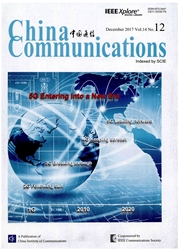

 中文摘要:
中文摘要:
In order to meet the exponentially increasing demand on mobile data traffic, self-backhaul ultra-dense networks(UDNs) combined with millimeter wave(mm Wave) communications are expected to provide high spatial multiplexing gain and wide bandwidths for multi-gigabit peak data rates. In selfbackhaul UDNs, how to make the radio access rates of small cells match their backhaul rates by user association and how to dynamically allocate bandwidth for the access links and backhaul links to balance two-hop link resources are two key problems on improving the overall throughputs. Based on this, a joint scheme of user association and resource allocation is proposed in self-backhaul ultra-dense networks. Because of the combinatorial and nonconvex features of the original optimization problem, it has been divided into two subproblems. Firstly, to make the radio access rates of small base stations match their backhaul rates and maximize sum access rates per Hz of all small cells, a proportional constraint is introduced, and immune optimization algorithm(IOA) is adopted to optimize the association indicator variables and the boresight angles of between users and base stations. Then, the optimal backhaul and access bandwidths are calculated by differentiating the general expression of overall throughput. Simulation results indicatethat the proposed scheme increases the overall throughputs significantly compared to the traditional minimum-distance based association scheme.
 英文摘要:
英文摘要:
In order to meet the exponentially increasing demand on mobile data traffic, self-backhaul ultra-dense networks (UDNs) combined with millimeter wave (mmWave) communications are expected to provide high spatial multiplexing gain and wide bandwidths for multi-gigabit peak data rates. In self- backhaul UDNs, how to make the radio access rates of small cells match their backhaul rates by user association and how to dynamically allocate bandwidth for the access links and backhaul links to balance two-hop link resources are two key problems on improving the overall throughputs. Based on this, a joint scheme of user association and resource allocation is proposed in self-backhaul ultra-dense networks. Because of the combinatorial and nonconvex features of the original optimization problem, it has been divided into two subproblems. Firstly, to make the radio access rates of small base stations match their backhaul rates and maximize sum access rates per Hz of all small cells, a proportional constraint is introduced, and immune optimization algorithm (IOA) is adopted to optimize the association indicator variables and the boresight angles of between users and base stations. Then, the optimal backhaul and access bandwidths are calculated by differentiating the general expression of overall throughput. Simulation results indicatethat the proposed scheme increases the overall throughputs significantly compared to the traditional minimum-distance based association scheme.
 同期刊论文项目
同期刊论文项目
 同项目期刊论文
同项目期刊论文
 期刊信息
期刊信息
